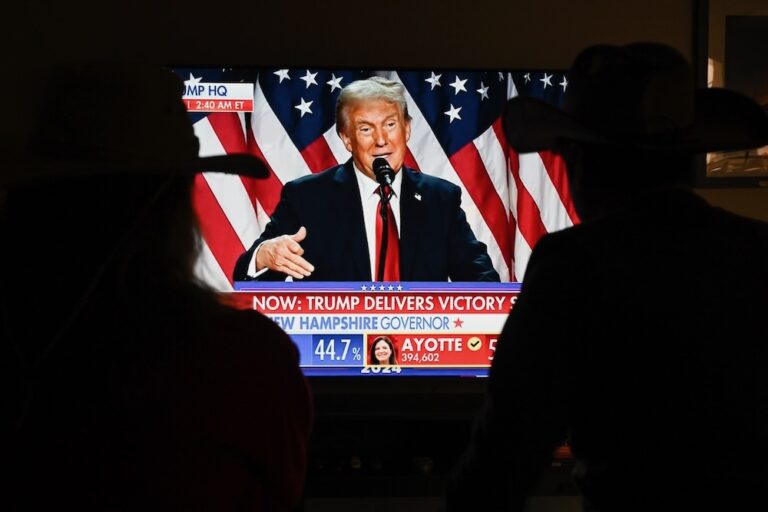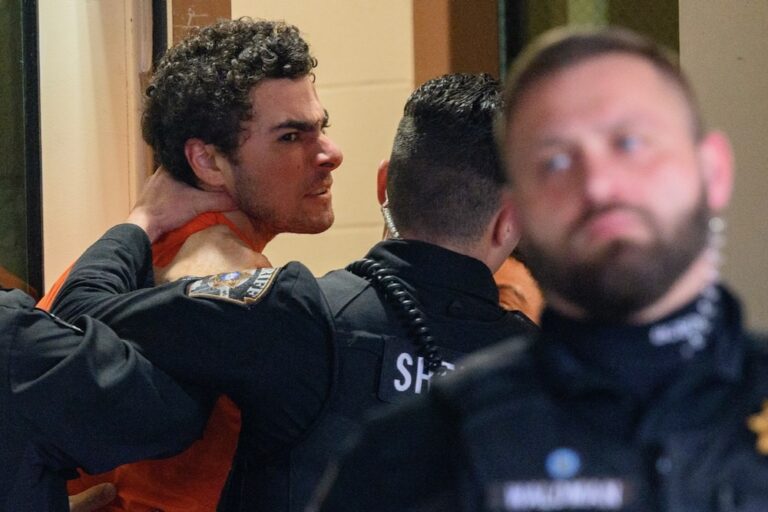Police in Ferguson, Missouri should stop using intimidation tactics against peaceful protesters and journalists following the police killing of a young African-American man on 9 August 2014.
Police in Ferguson, Missouri should stop using intimidation tactics against peaceful protesters and journalists following the police killing of a young African-American man on August 9, 2014.
Protests erupted in Ferguson, a predominantly African-American suburb north of St. Louis, after a police officer shot and killed Michael Brown, an unarmed 18-year-old. While some looting was reported, many media reports and accounts by witnesses have described the protests as largely peaceful. Police have responded with apparently unnecessarily threatening measures – such as pointing military assault rifles at peaceful protesters and deploying armored vehicles. And they have possibly used excessive force – including the unnecessary use of teargas, shooting rubber bullets into crowds, and detaining journalists covering the events.
“Ferguson police are compounding problems with threats and the use of unnecessary force against people peacefully protesting the police killing of Michael Brown,” said Alba Morales, US researcher at Human Rights Watch. “They should be upholding basic rights to peaceful assembly and free speech, not undermining them.”
Since Brown’s death, there have been daily vigils and protests, both planned and spontaneous. Protests the following night were reported as large and mostly peaceful. Looting reportedly damaged 12 businesses and resulted in 32 arrests, though there is no evidence that the looting was associated with any of the vigils or protests. Tensions escalated between the community and the police. In one video, an officer is heard telling protesters to, “Bring it, you fucking animals.”
On August 13, protesters and police in riot gear clashed. Journalists reported members of elite police SWAT teams pointing rifles at protesters at a church-organized gathering, and firing teargas canisters at retreating protesters. There were reports that police fired rubber bullets at protesters who remained on the street. Police also fired teargas canisters and rubber bullets at an Al Jazeera crew that was filming the events from behind a police barricade, according to members of the film crew and other witnesses.
Ferguson police stated that their actions were a necessary response to protester violence, including rock-throwing and the use of Molotov cocktails.
The International Covenant on Civil and Political Rights, which the US ratified in 1992, protects the rights to peaceful assembly and freedom of expression.
While some protester action may warrant forcible police intervention, international human rights standards limit the use of force to situations in which it is strictly necessary. The United Nations Basic Principles on the Use of Force and Firearms provide that law enforcement officials may only use force if other means remain ineffective or without any promise of achieving the intended result. When using force, law enforcement officials should exercise restraint and act in proportion to the seriousness of the offense and to the legitimate objective to be achieved.
Also on August 13, 2014, Ferguson police ordered two journalists – the Huffington Post’s Ryan Reilly and the Washington Post’s Wesley Lowery – to leave a McDonald’s restaurant where they were working. Lowery was wearing his press credentials at the time; Reilly was not. Lowery later reported that police officers grabbed him as he was attempting to comply with the order to leave, and that one officer slammed him into a soda machine.
Police took the two journalists to the precinct station and held them for about 15 minutes. Lowery reported that he believes the two journalists were released because police confirmed they were members of the media. The LA Times reported that when the Ferguson police chief was told that police had detained journalists, his response was “Oh God.”
President Barack Obama, in an August 14 statement calling for restraint by all sides in Ferguson, stated that, “police should not be bullying or arresting journalists who are just trying to do their jobs and report to the American people on what they see on the ground.”
“There’s no justification for police to detain journalists or lob teargas canisters at members of the press who are simply doing their jobs,” Morales said.
Police shot Brown as he walked to his grandmother’s house with Dorian Johnson, a friend. Two officers in a police cruiser approached the young men and ordered them to stop walking in the middle of the street, Johnson told the media. He said that the officers then drove toward them and that one of the officers reached out of the car and grabbed Brown by the neck. Johnson said that Brown tried to pull away and the officer fired. Johnson and Brown ran, and the officer got out of his car in pursuit and fired repeatedly, striking Brown several times, and killing him.
The police have stated that the incident began with “a physical confrontation” during which Brown assaulted the officer in the police car and tried to grab the officer’s gun.
Brown’s body was 35 feet from the police car. Police do not contest reports that Brown was unarmed. Some witnesses say he had his hands up when the final shots were fired. Police have not released the name of the officer who fired the shots, saying that his safety would be at risk.
The St. Louis police department, which is separate from the Ferguson police department, is handling the investigation into the shooting. On August 11, the US Federal Bureau of Investigation (FBI) opened its own investigation into possible civil rights violations.
On August 14, the governor of Missouri announced that security in Ferguson will be taken over by the Missouri State Highway Patrol under the command of Capt. Ron Johnson, an African-American who grew up in the community.
The Michael Brown killing raises serious concerns of discriminatory practices by the Ferguson police, Human Rights Watch said. The population of Ferguson is 69 percent black, but its 53-member police force employs only three black officers. Last year, the Missouri attorney general reported that blacks were twice as likely as whites to be arrested during traffic stops in Ferguson.
The state and federal investigations should be conducted promptly, thoroughly, and transparently, providing the public with as much information as possible.
“A meaningful investigation of the Brown case will be critical to address the very legitimate concerns of the people of Ferguson,” Morales said. “Meanwhile, police in Ferguson need to make sure they don’t make the situation worse by preventing protesters and the media from exercising their basic rights.”



